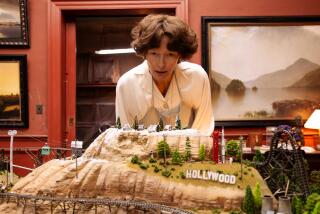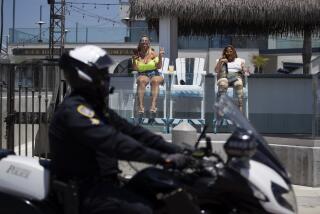‘I never thought it would come to this. I’m a prisoner in my own home.’ : The Cats and the Coyotes
- Share via
The apartment complex on Telfair Street is a well-kept wood and stucco building with a grassy courtyard in its U-shaped center. Two large pepper trees shade an area where small children play and tenants gather on warm days to exchange pleasantries.
The complex is a blend of young marrieds just getting started and older couples who have given up running a larger household for the easier life of a small apartment. They coexist in amiable harmony, and some have become close friends.
With its balanced mix of races and generations, the 17-unit cluster in suburban Sun Valley could serve as a model of what human relations ought to be.
Instead it has become a symbol of urban society under siege: a hunting ground of fear and foreboding where the forest belongs to the predator and the life span of its prey depends on an ability to hide.
“We are,” one tenant has said, “the cats, and they are the coyotes.”
This is the story of Telfair Street.
A month ago, a man was caught trying to burglarize one of the units in a search for drugs. Tenants joined in his capture and held him for police. As the man was led away, he shouted, “I’ll be back. I’m Sol Trece!”
Then the terror began. Sol Trece, or Sun 13, is a local gang. No one knows for certain that its members are responsible, but since that threat of vengeance, the lovely, peaceful apartment unit has been the target of 15 attempted break-ins.
Automobile tires have been slashed, windows broken, an entry gate wrecked and a woman beaten to the point of hospitalization for no apparent reason.
A police car parked just outside the complex was bombed while the officer stood in the tree-shaded courtyard discussing crime prevention with the tenants.
“If they won’t even respect the law,” a young woman asked, “what will they respect?”
A fellow tenant supplied an answer. “Guns,” he said.
Kim Roundtree, dark-eyed and frightened, stood in a doorway watching her four young children play, balanced between guarding them and listening for a fifth who napped inside.
“One night,” she said, “I heard a noise from a back room. I turned on a light to see a man trying to pry open the window. I screamed but he just looked at me. His expression was like so scream again, and he kept working to get in. He only ran when my husband took after him.”
She glanced around nervously, as though the man might still be there somewhere, watching.
“What if,” she asked, “my husband wasn’t there? What if I was alone with the kids?” A pause to consider the ultimate horror, then: “I’m scared to death.”
“Two Saturdays ago,” Bill Hoose said, “we came home to find our stereo, television set and wedding presents on the lawn. Apparently we surprised a burglar and he took off. We just got married and some of the presents weren’t even out of the boxes yet. I bought a gun.”
The tenants chipped in to hire a 24-hour security patrol.
“I keep wondering what good it’s going to do when the men on patrol can’t even carry night sticks,” Kim said.
“Some security,” Jim Clark said. “An old man walking around at night. I used to stay awake worrying about what the gangs might do to us. Now I stay awake worrying about what they’ll do to him. It’s driving me crazy.”
Jim, his wife, a new baby and two other children now sleep in the same room for protection. Jim, like Bill Hoose, is buying a gun.
“The owners have promised to put bars on the windows next week,” Kim said. “ Bars! I never thought it would come to this. I’m a prisoner in my own home.”
No one sleeps much anymore. All of them are deeply afraid. Those who don’t own guns have armed themselves with baseball bats and tire irons. One has a spear.
There is no question in their minds that the terror is caused by Sol Trece. But, in addition to blaming the gang, they also blame the police for not doing enough and the courts for not punishing enough and society for not caring enough.
“You know what the cop who had his car bombed told us?” Bill asked. “To be ready. All right. We’re ready.”
Terror causes an extreme of responses. It either paralyzes the prey and makes it an easy victim for the predator or fires even the weakest among them to turn and fight. In the apartment complex on Telfair Street, the game of cat and coyote is undergoing a change.
They’ve stopped hiding.
“We want to catch one of the punks,” Bill Hoose said. “Just one. We’ll tie him to a tree and leave what’s left for the cops.”
“If he comes to my house,” Kim Roundtree said, “he’ll be lucky if there’s anything left for the cops.”
“No more fun and games,” Jim Clark said.
It’s too bad, isn’t it? I mean, here was a place of rare achievement, 17 families in a commune-like setting, blacks, whites and Chicanos, living together, liking each other, making it all work.
And now guns. And now bars. And now threats.
A man on Telfair Street phrased it best. “Good God,” he asked, “what’s happening to us?”
More to Read
Sign up for Essential California
The most important California stories and recommendations in your inbox every morning.
You may occasionally receive promotional content from the Los Angeles Times.










